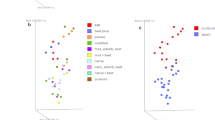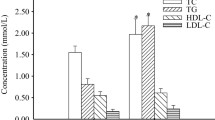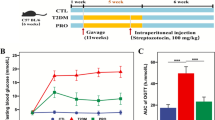Abstract
Beneficial symbionts residing in our gut have positive therapeutic effects on several metabolic disorders including diabetes. Oral administration of probiotic and prebiotic foods strengthens the beneficial symbiont populations in the gut and may prevent immune-mediated destruction of pancreatic β-cells. The present study was designed to elucidate the gut microbiome of diabetic rats supplemented with a Lactobacillus probiotic and a Saccharomyces cerevisiae (SC) cell wall prebiotic. Diabetes mellitus was induced in male Wistar rats with allaxon monohydrate (150 mg/kg). The rats were fed chow maintenance diet (control and diabetic control groups) or the same diet supplemented with a SC prebiotic (1 %), probiotic (multispecies Lactobacillus @108 CFU), or synbiotic. On d30, DNA was extracted from colon digesta for 16S ribosomal RNA (rRNA) gene sequencing. Serum was obtained to estimate total oxidant and anti-oxidant concentrations. A distinct clustering pattern (Unifrac distances, analysis of similarities (ANOSIM) P = 0.0361) was observed for the different treatment groups, with the main distinction consisting of the separation between the control and the diabetic control groups. Distinct bacterial clades dominated different treatment groups, particularly for the control and the diabetic control groups, though several bacterial groups overlapped, demonstrating a core microbiota dominated mainly by Firmicutes and Bacteroides. A trend of dysbiosis, characterized by low species richness, was observed in the diabetic rats, albeit not statistically significant. Serum oxidant and anti-oxidant concentrations were not different (P > 0.05) among different treatment groups. No significant effects of supplementations of prebiotic, probiotic, and synbiotic were observed on species richness or clustering pattern of the microbiome.




Similar content being viewed by others
References
Arrick DM, Mayhan WG. Cerebrovascular disease in type 1 diabetes: role of oxidative stress. studies in diabetes: Springer; 2014. p. 13-36.
Wen L, Ley RE, Volchkov PY, Stranges PB, Avanesyan L, Stonebraker AC, et al. Innate immunity and intestinal microbiota in the development of type 1 diabetes. Nature. 2008;455:1109–13.
Abbas Z, Jafri W. Yoghurt (dahi): a probiotic and therapeutic view. J Pak Med Assoc. 1992;42:221–4.
Bourlioux P, Koletzko B, Guarner F, Braesco V. The intestine and its microflora are partners for the protection of the host: report on the Danone Symposium “The Intelligent Intestine,” held in Paris, June 14, 2002. Am J Clin Nutr. 2003;78:675–83.
Watson JD. Type 2 diabetes as a redox disease. Lancet. 2014;383:841–3.
Musso G, Gambino R, Cassader M. Interactions between gut microbiota and host metabolism predisposing to obesity and diabetes. Annu Rev Med. 2011;62:361–80.
Qin J, Li Y, Cai Z, Li S, Zhu J, Zhang F, et al. A metagenome-wide association study of gut microbiota in type 2 diabetes. Nature. 2012;490:55–60.
Delzenne NM, Neyrinck AM, Bäckhed F, Cani PD. Targeting gut microbiota in obesity: effects of prebiotics and probiotics. Nat Rev Endocrinol. 2011;7:639–46.
Ghosh S, van Heel D, Playford RJ. Probiotics in inflammatory bowel disease: is it all gut flora modulation? Gut. 2004;53:620–2.
Schultz M, Linde HJ, Lehn N, Zimmermann K, Grossmann J, Falk W, et al. Immunomodulatory consequences of oral administration of Lactobacillus rhamnosus strain GG in healthy volunteers. J Dairy Res. 2003;70:165–73.
Yadav H, Jain S, Sinha PR. Oral administration of dahi containing probiotic Lactobacillus acidophilus and Lactobacillus casei delayed the progression of streptozotocin-induced diabetes in rats. J Dairy Res. 2008;75:189–95.
Ejtahed HS, Mohtadi-Nia J, Homayouni-Rad A, Niafar M, Asghari-Jafarabadi M, Mofid V. Probiotic yogurt improves antioxidant status in type 2 diabetic patients. Nutrition. 2012;28:539–43.
Roberfroid MB. Prebiotics and probiotics: are they functional foods? Am J Clin Nutr. 2000;71:1682s–7s.
Park DY, Ahn YT, Huh CS, McGregor RA, Choi MS. Dual probiotic strains suppress high fructose-induced metabolic syndrome. World J Gastroenterol. 2013;19:274–83.
Matsuzaki T, Nagata Y, Kado S, Uchida K, Kato I, Hashimoto S, et al. Prevention of onset in an insulin-dependent diabetes mellitus model, NOD mice, by oral feeding of Lactobacillus casei. APMIS. 1997;105:643–9.
Gobinath D, Madhu AN, Prashant G, Srinivasan K, Prapulla SG. Beneficial effect of xylo-oligosaccharides and fructo-oligosaccharides in streptozotocin-induced diabetic rats. Br J Nutr. 2010;104:40–7.
Hosseinzadeh P, Djazayery A, Mostafavi S-A, Javanbakht MH, Derakhshanian H, Rahimiforoushani A, et al. Brewer’s yeast improves blood pressure in type 2 diabetes mellitus. Iran J Public Health. 2013;42:602.
Hosseinzadeh P, Javanbakht MH, Mostafavi S-A, Djalali M, Derakhshanian H, Hajianfar H, et al. Brewer’s yeast improves glycemic indices in type 2 diabetes mellitus. Int J Prev Med. 2013;4:1131.
de Goffau MC, Fuentes S, van den Bogert B, Honkanen H, de Vos WM, Welling GW, et al. Aberrant gut microbiota composition at the onset of type 1 diabetes in young children. Diabetologia. 2014;57:1569–77.
Giongo A, Gano KA, Crabb DB, Mukherjee N, Novelo LL, Casella G, et al. Toward defining the autoimmune microbiome for type 1 diabetes. ISME J. 2010;5:82–91.
Erel O. A new automated colorimetric method for measuring total oxidant status. Clin Biochem. 2005;38:1103–11.
Erel O. A novel automated direct measurement method for total antioxidant capacity using a new generation, more stable ABTS radical cation. Clin Biochem. 2004;37:277–85.
Klindworth A, Pruesse E, Schweer T, Peplies J, Quast C, Horn M, et al. Evaluation of general 16S ribosomal RNA gene PCR primers for classical and next-generation sequencing-based diversity studies. Nucleic Acids Res. 2012:gks808.
Arndt D, Xia J, Liu Y, Zhou Y, Guo AC, Cruz JA, et al. METAGENassist: a comprehensive web server for comparative metagenomics. Nucleic Acids Res. 2012;40:W88–95.
Larsen N, Vogensen FK, van den Berg FW, Nielsen DS, Andreasen AS, Pedersen BK, et al. Gut microbiota in human adults with type 2 diabetes differs from non-diabetic adults. PLoS One. 2010;5:e9085.
Lozupone C, Knight R. UniFrac: a new phylogenetic method for comparing microbial communities. Appl Environ Microbiol. 2005;71:8228–35.
Everard A, Lazarevic V, Derrien M, Girard M, Muccioli GG, Neyrinck AM, et al. Responses of gut microbiota and glucose and lipid metabolism to prebiotics in genetic obese and diet-induced leptin-resistant mice. Diabetes. 2011;60:2775–86.
Maritim A, Sanders R, Watkins JB. Diabetes, oxidative stress, and antioxidants: a review. J Biochem Mol Toxicol. 2003;17:24–38.
Pourabedin M, Xu Z, Baurhoo B, Chevaux E, Zhao X. Effects of mannan oligosaccharide and virginiamycin on the cecal microbial community and intestinal morphology of chickens raised under suboptimal conditions. Can J Microbiol. 2014;60:255–66.
Upadrasta A, O’Sullivan L, O’Sullivan O, Sexton N, Lawlor PG, Hill C, et al. The effect of dietary supplementation with spent cider yeast on the swine distal gut microbiome. PLoS One. 2013;8:e75714.
Peng J, Narasimhan S, Marchesi JR, Benson A, Wong FS, Wen L. Long term effect of gut microbiota transfer on diabetes development. J Autoimmun. 2014.
Author information
Authors and Affiliations
Corresponding author
Ethics declarations
The present study was partially sponsored by the American Association for the Advancement of Science under AAAS–CSTSP International Activity for BMENA Scientific Exchange Program. MU Sohail visited Texas A&M University under AAAS-BMENA Scientific Exchange Program. Other than this, authors declare no conflict of interest.
All procedures and protocols were adopted under the guidelines of the Animal Care and Ethics Committee, Offices of Research, Innovation, and Commercialization, GC University Faisalabad, Pakistan.
Electronic supplementary material
Below is the link to the electronic supplementary material.
Table S1
Differences in bacterial taxa on various phylogenetic levels among different treatment groups. (DOCX 32 kb)
Figure S1
Serum glucose concentrations (mg/dL) on d 30 of the study. (TIFF 71 kb)
Figure S2
Serum total oxidant (μm of H2O2 equivalent/L) concentrations and total anti-oxidant (mM Eq. of vitamin C/L) concentrations. (TIF 40 kb)
Rights and permissions
About this article
Cite this article
Sohail, M.U., Shabbir, M.Z., Steiner, J.M. et al. Molecular analysis of the gut microbiome of diabetic rats supplemented with prebiotic, probiotic, and synbiotic foods. Int J Diabetes Dev Ctries 37, 419–425 (2017). https://doi.org/10.1007/s13410-016-0502-9
Received:
Accepted:
Published:
Issue Date:
DOI: https://doi.org/10.1007/s13410-016-0502-9




